
The superfamily Apoidea is a major group within the Hymenoptera, which includes two traditionally recognized lineages, the "sphecoid" wasps, and the bees. Molecular phylogeny demonstrates that the bees arose from within the traditional "Crabronidae", so that grouping is paraphyletic, and this has led to a reclassification to produce monophyletic families.
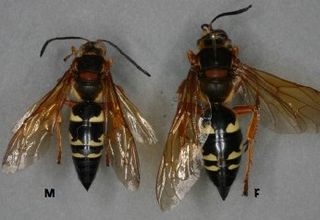
Sphecius speciosus, the eastern cicada-killer wasp, is a large, solitary digger wasp species in the family Bembicidae. They are so named because they hunt cicadas and provision their nests with them. Cicada killers exert a measure of natural control on cicada populations, and as such, they may directly benefit the deciduous trees upon which the cicadas feed. Sometimes, they are erroneously called sand hornets, despite not truly being hornets, which belong to the family Vespidae.
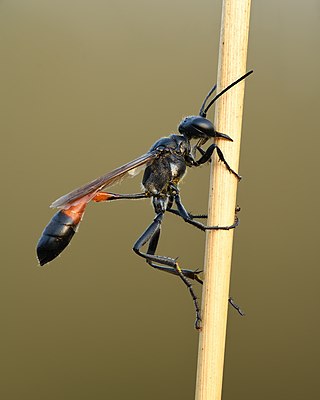
The Sphecidae are a cosmopolitan family of wasps of the suborder Apocrita that includes sand wasps, mud daubers, and other thread-waisted wasps.
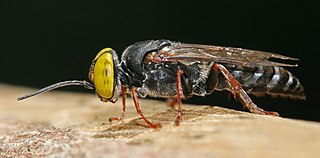
The Crabronidae is a large family of wasps within the superfamily Apoidea.

The brown marmorated stink bug is an insect in the family Pentatomidae, native to China, Japan, Korea, and other Asian regions. In September 1998, it was collected in Allentown, Pennsylvania, where it is believed to have been accidentally introduced. The nymphs and adults of the brown marmorated stink bug feed on over 100 species of plants, including many agricultural crops, and by 2010–11 had become a season-long pest in orchards in the Eastern United States. In 2010, in the Mid-Atlantic United States, $37 million in apple crops were lost, and some stone fruit growers lost more than 90% of their crops. Since the 2010s, the bug has spread to countries such as Georgia and Turkey and caused extensive damage to hazelnut production. It is now established in many parts of North America, and has recently become established in Europe and South America.
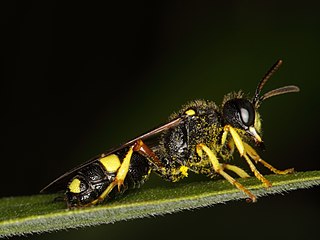
Cerceris is a genus of wasps in the family Philanthidae. It is the largest genus in the family, with 876 described species and 169 subspecies. The genus has a cosmopolitan distribution, with species on every continent.
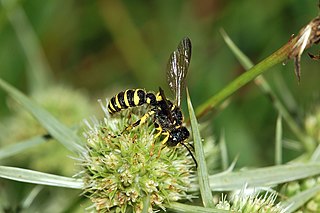
Philanthidae is one of the largest families of wasp in the superfamily Apoidea, with 1167 species in 8 genera, most of which are Cerceris.
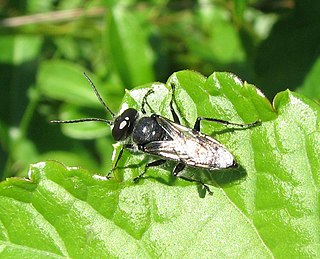
Astata is a cosmopolitan genus of solitary predatory wasps in the family Astatidae. They are known to prey on adults and nymphs of Pentatomidae. Astata is the largest genus in this subfamily, and is identified by features of its wing venation. The males of this genus and the related genus Dryudella have very large compound eyes that broadly meet at the top of the head.

Bagrada hilaris is a species of shield bug known by the common names bagrada bug and painted bug. It could be mistaken for or erroneously referred to as harlequin bug. It is native to southeastern Africa. It is known elsewhere as an introduced species, including California and Arizona, where it was first reported in 2008. It is a major pest insect of Brassica oleracea crops, and related crucifers such as turnips, rape, and mustard. The adult and nymph of the species suck sap from the leaves of the plants, causing wilting, yellowing, and stunting of growth. Besides crucifers, the bugs are known on papaya, sorghum, maize, potato, cotton, caper, pearl millet, and some legumes. Large numbers of the bug congregate on the plants and cause extensive damage.

Trissolcus japonicus, the samurai wasp, is a parasitoid wasp species in the family Scelionidae, native to east Asia but now found in Europe, North America, and Chile. It is chiefly known for parasitizing Halyomorpha halys. It deposits eggs into the eggs of the stink bug, and as the wasp larvae develop, they kill the stink bug eggs. A single adult wasp emerges from each stink bug egg.
Astata occidentalis is a species of wasp in the family Astatidae. It is found in Central America and North America.

Psenidae is a family of aphid wasps in the superfamily Apoidea formerly treated as the tribe Psenini. There are 12 genera and at least 485 described species of Psenidae.
Trypoxylon lactitarse is a species of square-headed wasp in the family Crabronidae. It is found in North, Central, and South America, and said to range from Canada to Argentina. These are fairly common harmless solitary wasps, although as with others of this same genus, the adult males can be observed to guard the nests. This species is well-characterised as nesting in pre-existing cavities which has facilitated ecological studies, as females can be easily attracted to nest in human-made trap-nests. Females construct a linear series of cells that are subdivided by mud partitions. In the south of range, nesting activity has been recorded to occur throughout the year, although may be more common in certain months. They can begin construction of their nests with a layer of mud, followed by the formation of a linear series of 6-8 cells.

Sphecius convallis, the Pacific cicada killer, is a species of sand wasp in the family Bembicidae. It is found in Central America and North America.>
Astata bicolor is a species of wasp in the family Astatidae. It is found in Central America and North America.
Sphecius hogardii, the Caribbean cicada killer, is a species of sand wasp in the family Bembicidae. It is found in the Caribbean and North America.
Liris argentatus is a species of square-headed wasp in the family Crabronidae. It is found in the Caribbean, Central America, North America, and Oceania. Females overwinter as adults.
Cerceris californica is a species of wasp in the family Philanthidae. It is found in Central America and North America. This species is a predator of Buprestidae beetles.
Mimumesa unicolor is a Palearctic species of solitary wasp.
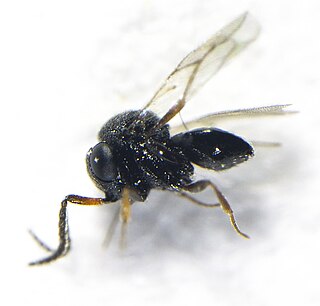
Trissolcus oenone is a parasitoid wasp in the family Platygastridae, native to Australia and New Zealand. It parasitises the eggs of stink bugs (Pentatomidae), but little is known about its biology.












